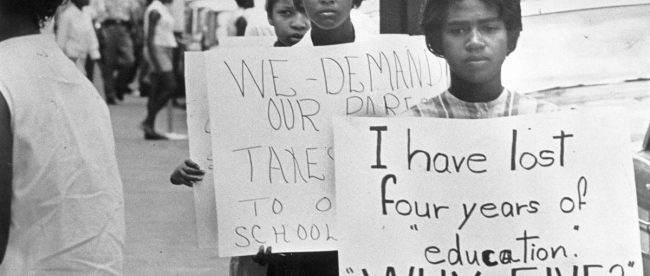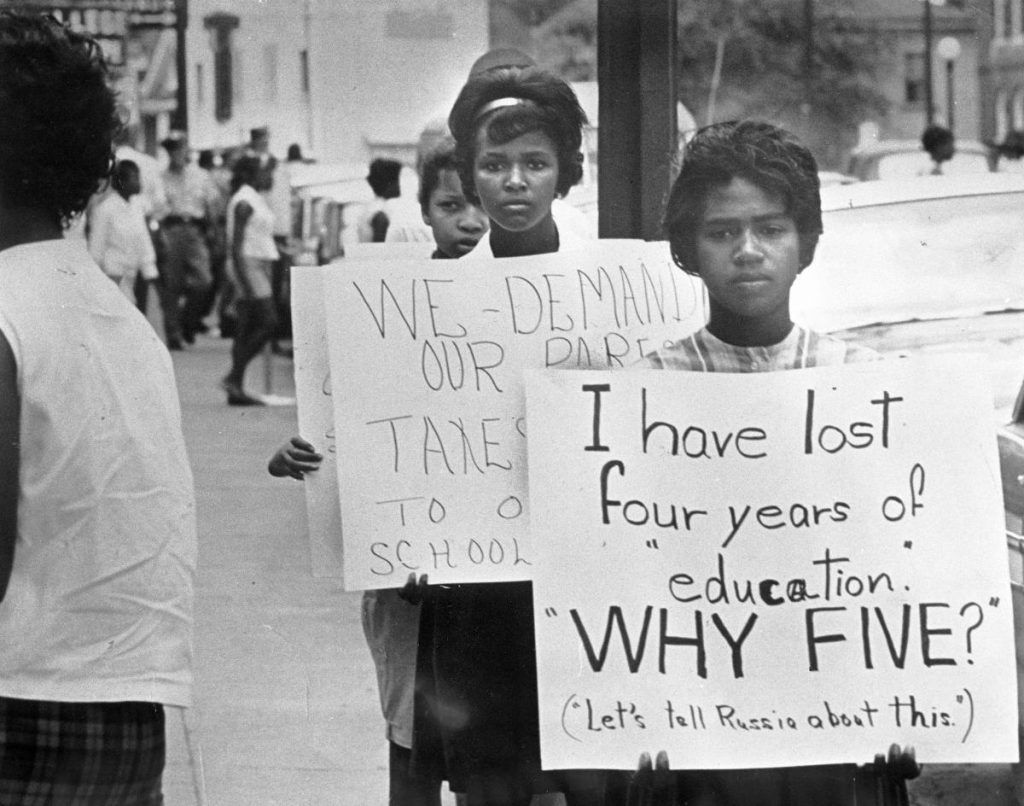They Called it “Massive Resistance”


May 17, 1954, was a bright moment in American history. By unanimous vote, the Supreme Court ruled that segregated public schools were inherently unequal and therefore an affront to the Constitution. The court case, Brown v. Board of Education, began the national process of integration.
But it was a process and one which met a lot of resistance — to the point where in Virginia, lawmakers literally dubbed their anti-integration plans “massive resistance.” The state government issued a multi-pronged plan to keep blacks and white separated. Among other legislation, the plan automatically closed schools that chose to desegregate immediately, and school districts had to offer tuition grants to now-displaced students instead. Districts that wanted to reopen integrated schools could only do so only after Governor Thomas Be. Stanley had the opportunity to persuade black pupils to self-segregate; if he failed, and the local school district still wished to reopen the integrated school, the district received no state funding. Either way, the tuition grants meant many white students left for segregated schools.
By 1959, courts struck down that set of laws. It seemed like Virginia’s public schools would finally have to integrate, and many began to. But one county — Prince Edward County, in the central part of the state — had another idea:
Rather than permit black kids to learn alongside their white kids, they wouldn’t offer public education at all.
Instead of operating public schools, the school board decided to close its schools and shift entirely to a tuition grant system — all students, regardless of race, received a tuition grant that could be used at any local private school. Of course, this was an empty gift for the black population, as all of the private schools remained racially segregated. The most notable one, the Prince Edward Academy (now the Fuqua School), became the de facto public school in the area — but for whites only. As the National Endowment for the Humanities notes, “Some 1,700 [black] students were shut out. Meanwhile, the private Prince Edward Academy opened with nearly 1,450 [white] students from kindergarten to high school.” Black students were left to fend for themselves, with poor results. The University of Richmond’s “History Engine” summarizes one example:
Everett Berryman, Jr. who was twelve at the time public schools closed, explained that he attended a grassroots training center run by his mother instead of public school. He did not know that he was missing out on anything until his cousin from Baltimore proved much more proficient in reading and math than Everett. To get a good education, Everett was forced to move in with a family friend so that he could attend school in nearby Appomattox County.
The NAACP initiated litigation nearly immediately, but courts move slowly and resistance went away even more slowly. Per the NEH, “in August 1961, a federal court in Richmond ruled that Prince Edward could not use public money to fund private education as long as the public schools were closed.” But even then, the county did not re-open its public schools; they opted to, instead, have white families pay their own way to attend the Academy. Most of those who could afford to did, but not everyone could. Rather than allow white students and black students to receive an education side-by-side, the county government opted to now deny an education to some white students as well.
Prince Edward County’s terrible approach finally came to an end on May 24, 1964, more than a decade after Brown v. Board of Education. In Griffin v. County School Board of Prince Edward County, the Supreme Court ruled 9-0 that closing schools in lieu of integrating also violated the Constitution. Further, a 7-2 majority of the judges took the unprecedented step of requiring that county continue to raise taxes from its constituents, fearing that the county would simply force itself broke rather than integrating its schools. The next September, the public schools reopened.
But the damage had already been done — the area’s schools remained effectively segregated despite the reopening. As the NEH notes, “nearly all the [public school] students were black, and the private academy continued to operate [as a white’s only institution].”
Bonus fact: The Brown v. Board of Education hearing in front of the Supreme Court was actually five different cases combined into one. One of those five cases was Davis v. County School Board of Prince Edward County, stemming from the segregation in the same school system described above. The Davis case was different than the others, though, in one meaningful way: it was prompted by a student walkout. In 1951, the all-black public school was in shambles; per Wikipedia, “the school did not have a gymnasium, cafeteria or teachers’ restrooms. Teachers and students did not have desks or blackboards, and due to overcrowding, some students had to take classes in an immobilized, decrepit school bus parked outside the main school building.” In response, the school children, led by 16-year-old Barbara Rose Johns, went on a two-week general strike demanding additional funding for their school. The students ultimately changed course, demanding integrated schools, and the NAACP helped them litigate the case.
From the Archives: Coup d’USA: Another example of a community’s insistence that racism triumph.
